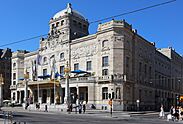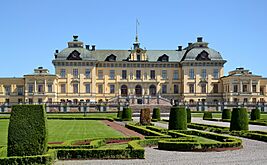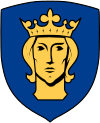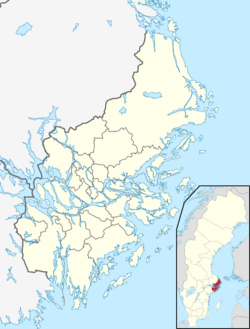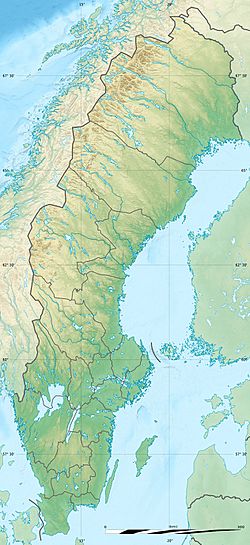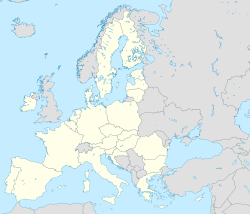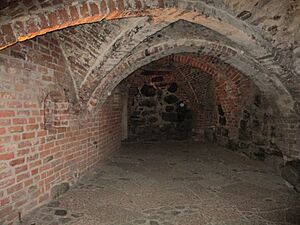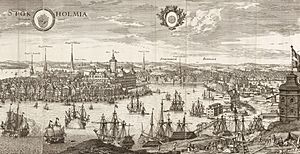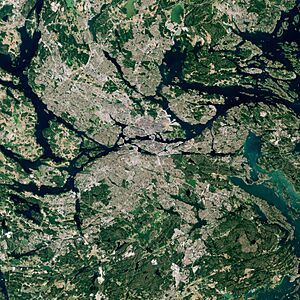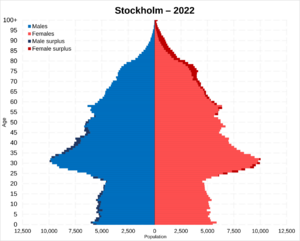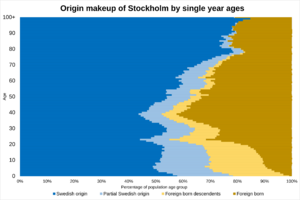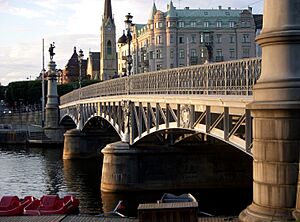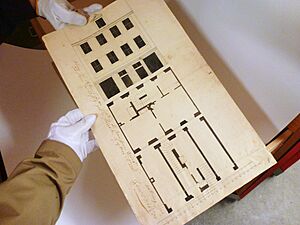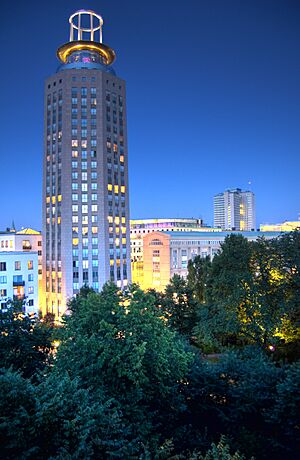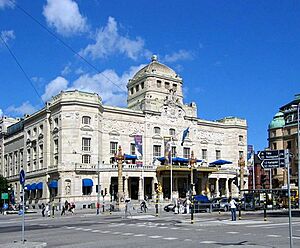Stockholm facts for kids
Quick facts for kids
Stockholm
|
|||
|---|---|---|---|
|
|
|||
|
|||
| Nickname(s):
Sthlm, Eken, the Venice of the North, the Venice of Scandinavia
|
|||
| Country | |||
| Province | Södermanland and Uppland | ||
| County | Stockholm County | ||
| First mention | 1252 | ||
| Charter | 13th century | ||
| Area | |||
| • Capital city | 188 km2 (73 sq mi) | ||
| • Urban | 381.63 km2 (147.35 sq mi) | ||
| • Metro | 6,519 km2 (2,517 sq mi) | ||
| Elevation | 28 m (92 ft) | ||
| Population
(2023)
|
|||
| • Capital city | 984,748 | ||
| • Density | 5,238/km2 (13,570/sq mi) | ||
| • Urban | 1,617,407 | ||
| • Urban density | 4,238.15/km2 (10,976.77/sq mi) | ||
| • Metro | 2,415,139 | ||
| • Metro density | 370.477/km2 (959.53/sq mi) | ||
| Demonyms |
|
||
| GDP | |||
| • Metro | €171.269 billion (2021) | ||
| Time zone | UTC+1 (CET) | ||
| • Summer (DST) | UTC+2 (CEST) | ||
| Postal code |
100 00-199 99
|
||
| Area code(s) | +46-8 | ||
Stockholm is the capital and largest city of Sweden. It is also the biggest urban area in the Nordic countries. About 1 million people live in the city itself. If you include the wider urban area, the population is 1.6 million. The larger metropolitan area has 2.4 million people.
Stockholm is built on fourteen islands. Here, Lake Mälaren flows into the Baltic Sea. East of the city, along the coast, is a chain of islands called the Stockholm archipelago. People have lived in this area since the Stone Age, around 6000 BC. The city was officially founded in 1252 by a Swedish leader named Birger Jarl. Stockholm is the main center for culture, media, politics, and business in Sweden.
The Stockholm region creates over a third of Sweden's total wealth. It is one of the top 10 regions in Europe for wealth per person. Stockholm is considered a global city. It is the largest city in Scandinavia and a major hub for big companies in the Nordic region. The city has some of Europe's best universities. These include the Karolinska Institute (for medicine), KTH Royal Institute of Technology, Stockholm School of Economics, and Stockholm University.
Stockholm hosts the yearly Nobel Prize ceremonies. These events take place at the Stockholm Concert Hall and Stockholm City Hall. The Vasa Museum is one of the city's most famous museums. It is the most visited museum in Scandinavia. The Stockholm metro, which opened in 1950, is famous for its decorated stations. People call it the longest art gallery in the world. Stockholm also hosted the 1912 Summer Olympics and many other international sports events.
Stockholm is Sweden's main financial centre. It is one of the biggest in Scandinavia. Many of Sweden's largest companies and banks have their main offices here. Stockholm is also a major tech hub in Europe. Some people call it Europe's innovation center. The Stockholm region has a lot of wealth. Stockholm County has the highest wealth per person among all counties in Sweden.
Stockholm is where the Swedish government is located. Most government offices and the highest courts are here. It is also the official home of the Swedish monarch and the Prime Minister. The government works in the Rosenbad building. The Riksdag (Swedish parliament) meets in the Parliament House. The Prime Minister lives at the Sager House. Stockholm Palace is the official home and workplace of the Swedish monarch. The Swedish Royal Family's private home is Drottningholm Palace in nearby Ekerö.
Contents
- Stockholm's Past: A City's Journey
- Stockholm's Location and Climate
- Stockholm's Economy: A Hub of Innovation
- Learning and Education in Stockholm
- People and Population in Stockholm
- Stockholm's Rich Culture
- Literature in Stockholm
- Stockholm's Architecture: Old and New
- Music Scene in Stockholm
- Museums to Explore in Stockholm
- Art in Stockholm
- Stockholm's Suburbs: Diverse Communities
- Theatre and Music Venues
- Amusement Park Fun
- Media Hub of Sweden
- Sports in Stockholm
- Food and Drink in Stockholm
- Yearly Events and Festivals
- Stockholm's Green Environment
- Getting Around Stockholm
- Stockholm's Global Recognition
- Sister Cities
- See also
Stockholm's Past: A City's Journey
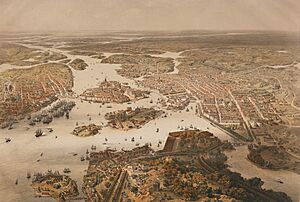
After the Ice Age, around 8000 BCE, people lived in the Stockholm area. But when it got colder, they moved south. Thousands of years later, the climate improved. People started moving back north. The Old Town of Stockholm was first built around 1000 CE by Vikings. This was at the point where the Baltic Sea meets Lake Mälaren. The Vikings helped trade in the area.
The name Stockholm first appeared in writing in 1252. By then, mines in Bergslagen made it important for iron trade. The first part of the name, "stock," means "log" in Swedish. It might also come from an old German word for "fortification." The second part, "holm," means "islet." This likely refers to Helgeandsholmen in central Stockholm.
According to an old story, the city was founded by Birger Jarl. He wanted to protect Sweden from sea attacks. These attacks came from Karelians.
Stockholm's main area, the Old Town (Gamla Stan), was built from the mid-13th century. The city became important because of trade in the Baltic Sea. This trade was part of the Hanseatic League. Stockholm had strong ties with cities like Lübeck and Hamburg. From 1296 to 1478, half of Stockholm's City Council members were German-speaking. This shows how important Germans were in trade back then.
The city's location and economy made it key in conflicts. These were between the Danish Kings and the Swedish independence movement. In 1520, the Danish King Christian II entered the city. On November 8, 1520, a terrible event happened. Many Swedish leaders who opposed the king were killed. This event is known as the Stockholm Bloodbath. It led to more uprisings and Sweden gaining independence.
When Gustav Vasa became king in 1523, Stockholm's population grew. By 1600, it reached 10,000 people.
In the 1600s, Sweden became a major European power. Stockholm grew a lot during this time. Its population increased six times between 1610 and 1680. In 1634, Stockholm became the official capital of the Swedish empire. New trade rules gave Stockholm a special right to trade with foreign merchants. In 1697, Tre Kronor Castle burned down. It was later replaced by Stockholm Palace. This era also saw many modern buildings built in the city.
The Swedish Empire also brought a new interest in arts and sciences. Queen Christina strongly supported science and culture. Famous thinkers like René Descartes lived in Stockholm. Inventors like Christopher Polhem moved to the city. Academics like Olaus Rudbeck also spent time in Stockholm.
Throughout history, Stockholm had walls to protect it. These walls were changed from the 13th to the 16th century. In 1625, a big fire destroyed part of Stadsholmen. This island is in the center of Stockholm. The damage led to the walls being taken down. Today, most of the old city walls are gone. But parts of the northern walls are kept in the Museum of Medieval Stockholm.
In 1710, a plague killed about 20,000 people. This was 36% of the population. After the Great Northern War, the city's growth slowed down. Stockholm was no longer the capital of a great power. But it remained Sweden's political, economic, and cultural center.
In the late 1700s, during the Age of Enlightenment, the city thrived. King Gustav III was a strong leader. His economic plans helped Sweden's economy. His war against Russia also improved Sweden's international standing. The king loved the arts. Scientists and artists came to Stockholm. This was a time of great cultural growth.
During this time, Carl Michael Bellman and Joseph Martin Kraus helped develop the city's music. The Royal Swedish Opera was founded. Many artists and writers became famous. They were supported by the king and others. These figures helped create the base for Sweden's Nationalmuseum. Science also grew. Famous people like Carl Linnaeus and Anders Celsius spent time in Stockholm. Research places like the Stockholm Observatory were started.
The early 1800s saw a decline in Stockholm's economy. But by the second half of the century, it recovered. New industries appeared with industrialization. Stockholm became an important center for trade and services. The population grew a lot, mostly due to people moving in. By the late 1800s, less than 40% of residents were born in Stockholm. Most new people came from poorer rural areas. The city began to expand beyond its old limits. Many scientific institutes and universities were also founded. These included the Karolinska Institutet and KTH Royal Institute of Technology. The General Art and Industrial Exposition was held in 1897. This event brought international attention to Stockholm.
In the 20th century, Stockholm became a modern and diverse city. Many old buildings were torn down during the modernist era. This included parts of the historic Klara district. They were replaced with modern buildings. However, many older buildings in areas like Gamla stan and Södermalm survived. Over the century, industries shifted from manufacturing to high-tech and service jobs. These industries still lead the city's economy today.
Stockholm's metropolitan area is one of Europe's fastest-growing regions. In 2020, Stockholm's population grew by 1,477 people. Because of this growth, there are plans to build tall buildings in the city center. These plans have faced some opposition.
Stockholm's Location and Climate
Where is Stockholm Located?
Stockholm is on Sweden's east coast. It is located at the 59th parallel north. This is where the fresh water of Lake Mälaren flows into the Baltic Sea. Lake Mälaren is Sweden's third-largest lake. The central parts of Stockholm are made up of fourteen islands. These islands are connected to the Stockholm archipelago. The city's center is on the water, in Riddarfjärden bay. Over 30% of the city is water. Another 30% is made up of parks and green spaces.
Stockholm is at the eastern end of the Central Swedish lowland. It is also near the Bergslagen region. This location was important for early Swedish trade with the Baltic region.
Stockholm has a Temperate deciduous forest climate. This means its weather is similar to the northeastern United States and coastal Nova Scotia in Canada. The average yearly temperature is 7.9°C (46.2°F). The average rainfall is 531 mm (20.9 inches) per year. This climate has four clear seasons: spring, summer, autumn, and winter. In autumn, leaves change color. In winter, trees lose their leaves.
Stockholm's City Districts
Stockholm Municipality is an administrative area with clear borders. The city is divided into district councils. These councils manage primary schools, social services, and cultural activities. The municipality has three main parts: Innerstaden (Stockholm City Centre), Söderort (Southern Stockholm), and Västerort (Western Stockholm).
Central Stockholm Areas
- Gamla Stan
- Kungsholmen
- Norrmalm
- Södermalm
- Vasastan
- Östermalm
Southern Stockholm Areas
- Enskede-Årsta-Vantör
- Farsta
- Hägersten-Liljeholmen
- Skarpnäck
- Skärholmen
- Älvsjö
Western Stockholm Areas
- Bromma
- Hässelby-Vällingby
- Rinkeby-Kista
- Spånga-Tensta
The modern center, Norrmalm, is around Sergels torg. It is Sweden's largest shopping area. It is the most important part of Stockholm for business and shopping.
Stockholm's Weather and Seasons
Stockholm has a humid continental climate. Winters are cold, but temperatures usually stay above freezing for most of the year. Summers are warm and pleasant. Rain falls throughout the year.
Because Stockholm is so far north, the amount of daylight changes a lot. In mid-summer, there are over 18 hours of daylight. In late December, there are only about 6 hours. Nights from late May to mid-July are not completely dark. Stockholm's weather is milder than other places at the same latitude. It also gets a lot of sunshine, about 1900 hours per year. This is more than Paris or London. Stockholm has the warmest July months among Nordic capitals. This is due to the urban heat island effect and winds coming over land. Stockholm usually has snow cover for 75 to 100 days a year.
Summers usually have daytime highs of 20–25°C (68–77°F). Lows are around 13°C (55°F). Temperatures can reach 30°C (86°F) on some days. Winters are often cloudy. Most rain or snow falls in December and January. Average winter temperatures are between -3 and -1°C (27–30°F). They can drop below -20°C (-4°F) in the city's outer areas. Spring and autumn are generally cool to mild.
The highest temperature ever recorded in Stockholm was 36°C (97°F) on July 3, 1811. The lowest was -32°C (-26°F) on January 20, 1814. The warmest month ever was July 2018, with an average temperature of 22.5°C (72.5°F). This was also a record for all of Sweden.
Yearly rainfall is 546.4 mm (21.5 inches). There are about 170 wet days. Rain is light to moderate throughout the year. More rain falls in the second half of the year. Snow usually falls from December to March. Sometimes, it snows in late October or April.
Sometimes, the aurora borealis (Northern Lights) can be seen in Stockholm.
Daylight Hours in Stockholm
Stockholm is just south of the 60th parallel north. This means daylight hours are short in winter, about six hours. In June and early July, nights are short, with about 18 hours of daylight. Because of its eastern location, sunsets can happen as early as 2:46 PM in mid-December. Around the summer solstice, the sun never goes more than 7.3 degrees below the horizon. This makes the sky bright blue in summer after sunset. It never gets completely dark. This is different from the midnight sun, which happens further north, above the Arctic Circle.
Stockholm's Economy: A Hub of Innovation
Stockholm is Sweden's main financial center. It is an important place for trade, finance, and technology in Europe. It is also one of Scandinavia's largest financial centers. The Stockholm region leads Sweden in wealth and wealth per person. It is among the ten wealthiest regions in the European Union.
Many of Sweden's biggest companies have their main offices in Stockholm. They are attracted by its central location, skilled workers, and strong financial sector. These companies include Ericsson, a huge telecommunications company. Another is Atlas Copco, a large industrial company. Other big companies based in Stockholm are Electrolux, H&M, and Securitas AB. Some of Europe's largest investment firms are also here. These include Investor AB and Nordstjernan. EQT AB is also headquartered in Stockholm.
Stockholm is a top center for the technology industry in Europe. This industry is mainly in Kista, a northern suburb. Kista is Europe's largest Information and Technology cluster. Stockholm has the second-highest number of "unicorns" (startup companies worth over $1 billion) per person in the world, after Silicon Valley. The city also has one of Europe's highest rates of new startups. Famous tech startups from Stockholm include Mojang, Spotify, and Klarna. Spotify and Klarna have been among the world's largest startup companies.
Most of Sweden's largest banks are based in Stockholm. These include the SEB Group, Handelsbanken, and Swedbank. The Stockholm Stock Exchange, founded in 1863, is the largest stock exchange in the Nordic Countries. It lists many international Swedish companies.
Trade is a key part of Stockholm's economy. The city's companies rely on foreign customers. Stockholm is one of the Baltic Sea's largest ports. It hosts many cruise ships and yachts. Most of Stockholm's economy is based on services that are exported. These often go to larger European markets like Poland or Germany. Tourism is also a big industry in Stockholm.
Learning and Education in Stockholm
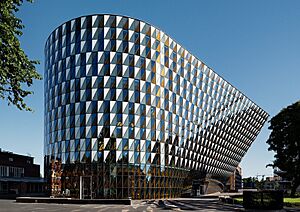
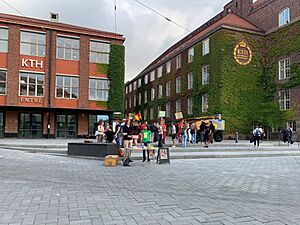

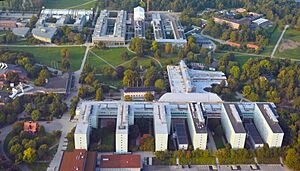
Research and higher education in science began in Stockholm in the 18th century. This included medical training and research places like the Stockholm Observatory. Medical education became official in 1811 as the Karolinska Institutet. KTH Royal Institute of Technology was founded in 1827. It is Scandinavia's largest technical university, with 13,000 students. It led many government research projects in the 20th century. Stockholm University, founded in 1878, has 52,000 students. It includes historical places like the Observatory and the Swedish Museum of Natural History. The Stockholm School of Economics, founded in 1909, is a private school. It is considered one of the best business schools in the world.
In the fine arts, there are several schools. These include the Royal College of Music, founded in 1771. The Royal University College of Fine Arts dates back to 1735. The Swedish National Academy of Mime and Acting is a continuation of the Royal Dramatic Theatre school. Famous actors like Greta Garbo attended it. Other schools include the design school Konstfack, founded in 1844. There is also the University College of Opera and the University College of Dance.
Södertörn University was founded in 1995. It is a multi-subject school for southern Metropolitan Stockholm. This helps balance the many schools in the northern part of the region. Other higher education places include the Military Academy Karlberg. This is the world's oldest military academy still in its original place. It opened in 1792 at Karlberg Palace. There is also the Swedish Defence University, Ersta Sköndal University College, and Swedish School of Sport and Health Sciences.
A common problem for students in Stockholm is finding housing. There is a lack of student dorms, and rent is high.
People and Population in Stockholm
The Stockholm region is home to about 22% of Sweden's total population. It also creates about 29% of the country's total wealth. The idea of "Stockholm" has changed over time. In the early 1800s, Stockholm was mostly the area now called City Centre. This was about 35 square kilometers (13.5 sq mi). Over the years, other areas joined the city. The city's border was set in 1971.
In 2022, Stockholm's population was 984,748. It is expected to reach 1,079,213 by 2030. About 482,982 residents were men and 492,569 were women. The average age is 39 years. About 40.1% of the population is between 20 and 44 years old.
As of December 2021, 252,750 people in Stockholm were born in other countries. This is 25.8% of the population. The largest groups of foreign-born people were from Iraq, Finland, Iran, and Poland. In total, 336,275 residents (34.4%) of Stockholm had a foreign background.
People who live in Stockholm are called Stockholmers (stockholmare). Besides Swedish, other languages are spoken. These include Finnish, which is an official minority language. English is also widely spoken. Other languages include Albanian, Bosnian, Arabic, Turkish, Kurdish, Persian, Somali, Spanish, Serbian, and Croatian.
Stockholm has had a large Finnish-speaking minority since the 13th century. By the late 1400s, up to 20% of Stockholm's population was Finnish. The Finnish Church opened in 1725. Stockholm has the largest Finnish population in Sweden, with 74,000 people of Finnish background. Finnish, along with Meänkieli and the Sami languages, has a protected minority status in Stockholm. This means people can use these languages when talking to authorities. They also have the right to child and elderly care in their languages. Romani chib and Yiddish are also recognized minority languages. They have special rights for education in their languages.
The entire Stockholm metropolitan area includes 26 municipalities. It has over 2.2 million people. This makes it the most populated region in the Nordic countries. The Stockholm urban area had a population of 1,630,738 in 2015.
| Municipality | Population (Year) | ||
|---|---|---|---|
| Stockholm | |||
| Botkyrka | |||
| Danderyd | |||
| Haninge | |||
| Huddinge | |||
| Järfälla | |||
| Nacka | |||
| Sollentuna | |||
| Solna | |||
| Sundbyberg | Tyresö |
Religious Communities in Stockholm
The Swedish church has 27 parishes in Stockholm. It has almost 50 churches. There are also many churches belonging to other Christian groups.
Stockholm has six mosques for the Muslim community.
There are three active synagogues in Stockholm. The Jewish community has 4,300 members. This is 0.4% of Stockholm's population. It is the largest Jewish community in Scandinavia.
Stockholm's Rich Culture
As Sweden's capital and largest city, Stockholm is the main center for the country's cultural life. The Swedish Royal Academies give out important awards. They also serve as intellectual groups for Sweden's top thinkers. The city has many amazing buildings. The Stockholm region is home to three World Heritage Sites. These are places considered very important to all of humanity. They are Drottningholm Palace, Skogskyrkogården (The Woodland Cemetery), and Birka. In 1998, Stockholm was named European Capital of Culture.
Literature in Stockholm
Since its beginning, Stockholm has been home to many famous writers. These include August Strindberg and Astrid Lindgren. Other important writers for Swedish literature include Vilhelm Moberg and Olof von Dalin. Stockholm has a lively literary scene. It hosts two important literary groups: the Swedish Academy and National Library of Sweden.
Literature in Stockholm started during the Viking Age. Many runestones were carved in the area. This was because it was an important trading place. However, early Swedish literature was mostly in Götaland and Uppsala.
In the 16th century, royal power grew in Stockholm. This led to Stockholm becoming more important in Swedish literature. King Gustav Vasa had the Bible translated into Swedish. He also brought many writers to his court.
Stockholm's literature really grew in the 17th century. Famous writers from all over Sweden moved to the city. This was because of the wealth and support from the Swedish Empire. This cultural growth continued into the 18th century. The Gustavian era was a peak time for Stockholm's literature. Carl Linnaeus's scientific writings were very influential. August Strindberg even called Linnaeus "a poet who happened to become a naturalist." Another important writer was Carl Michael Bellman. He was known for setting his poems to music. He is often called the father of the Swedish ballad tradition.
The 19th and 20th centuries were also good for Stockholm's literature. The Romantic and Realist movements appeared. August Strindberg became famous in the late 19th century. He is still considered one of Sweden's best writers. In the 20th century, Astrid Lindgren became famous for her children's stories. Vilhelm Moberg's works are seen as national treasures in Sweden.
Stockholm's Architecture: Old and New
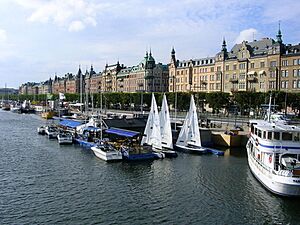
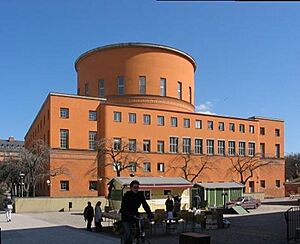
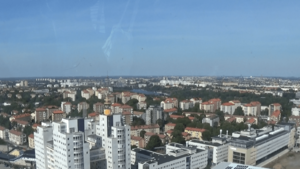
Stockholm's oldest part is Gamla Stan (Old Town). It is on the small islands where the city first started. It still has its medieval street layout. Some famous buildings in Gamla Stan include the large German Church. There are also several grand houses and palaces. These include the Riddarhuset and the Stockholm Palace.
The oldest building in Stockholm is Riddarholmen Church. It dates from the late 13th century. After a fire in 1697, Stockholm Palace was built in a Baroque style. Storkyrkan Cathedral is next to the castle. It was founded in the 13th century. Its Baroque outside was added in the 1730s-40s.
By the 15th century, the city had grown beyond its original borders. Some small, old buildings from this time can still be found in Södermalm. Norrmalm, now a central shopping area, was once a separate city. It became part of Stockholm in the early 17th century.
Stockholm has required building permits since the early 18th century. The oldest permit is from 1713. This means you can trace the history of a new house back three centuries. Today, the Stockholm City Building committee handles permits. Their old drawings from 1713 to 1874 are available online.
In the late 19th century, during industrialization, Stockholm grew fast. Its plans and buildings were inspired by big European cities like Berlin and Vienna. Important buildings from this time include the Royal Swedish Opera. Also, luxury homes were built on Strandvägen.
In the 20th century, a new architectural style appeared. It was inspired by medieval and renaissance designs. It also had influences from Jugend style. The Stockholm City Hall was built from 1911–1923 by Ragnar Östberg. Other famous works include the Stockholm Public Library by Gunnar Asplund. The World Heritage Site Skogskyrkogården was also designed by Asplund and Sigurd Lewerentz.
In the 1930s, modernism shaped the city's growth. New neighborhoods like Gärdet appeared. Industrial growth also contributed. In the 1950s, suburban development changed with the Stockholm metro. Modernist areas like Vällingby and Farsta were praised internationally. In the 1960s, suburban growth continued. However, the mass-produced apartment blocks received much criticism.
At the same time, the city center was redesigned. This was called Norrmalmsregleringen. Sergels Torg, with its five tall office towers, was created in the 1960s. Large areas were cleared for new projects. Famous buildings from this time include the House of Culture and City Theatre. These were designed by Peter Celsing.
The city created the "Skönhetsrådet" in 1919. Its job was to protect the city's beauty. It is still active in city planning and architecture debates.
Music Scene in Stockholm
As Sweden's cultural center, Stockholm is home to much of its music industry. The city has many music groups and popular musicians. Famous bands like ABBA and modern artists like Tim Bergling (Avicii) are from Stockholm. The most respected music places include the Royal Swedish Opera and Royal Swedish Academy of Music. Both were founded in the late 18th century. Important musical figures include Carl Michael Bellman, Joseph Martin Kraus, and Jenny Lind.
Stockholm became famous in modern music in the 20th century. The band ABBA, one of the most popular in history, became famous in the 1970s. Other popular bands formed in the 20th century include Roxette and Kent.
In the 21st century, Stockholm has had many influential musicians. Max Martin, a world-famous songwriter, is based here. Tim Bergling, known as Avicii, became famous in 2013 for his electronic music. Other popular modern musicians include Robyn and Eurovision winners Måns Zelmerlöw and Loreen. Allsång på Skansen, Sweden's biggest music festival, is held in Stockholm.
Museums to Explore in Stockholm
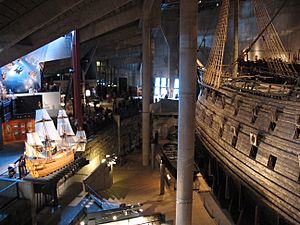
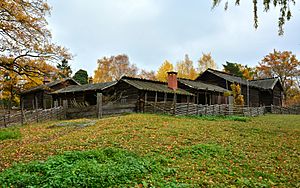
Stockholm is one of the cities with the most museums in the world. It has about 100 museums. Millions of people visit them every year.
The Vasa Museum (Vasamuseet) is a maritime museum on Djurgården. It shows the only almost complete 17th-century ship ever saved. This is the 64-gun warship Vasa. It sank on its first trip in 1628.
The Nationalmuseum has Sweden's largest art collection. It has 16,000 paintings and 30,000 art objects. The collection started in the 16th century with Gustav Vasa. It has works by artists like Rembrandt and Antoine Watteau. It also holds much of Sweden's art history. The museum was closed for restoration from 2013 to 2018. Moderna Museet (Museum of Modern Art) is Sweden's national museum for modern art. It has works by famous modern artists like Picasso and Salvador Dalí.
Skansen is an open-air museum and zoo. It is on the island of Djurgården. It was founded in 1891 by Artur Hazelius. He wanted to show how people lived in different parts of Sweden before the industrial age.
Other notable museums include:
- ABBA: The Museum, an interactive exhibit about the pop group ABBA.
- Swedish Army Museum, showing Swedish history from 1500 to today.
- Fotografiska, a modern museum for photography, art, and culture.
- Birka, the Viking City of Birka, a World Heritage Site.
- Livrustkammaren, the royal armoury, located at Stockholm Palace.
- Maritime Museum (Stockholm), for naval history and shipping.
- Medelhavsmuseet, focusing on ancient cultures around the Mediterranean.
- Millesgården, the home of sculptor Carl Milles, now a museum of his works.
- Museum of Far Eastern Antiquities, with art and culture from Asia.
- Swedish National Museum of Science and Technology, Sweden's largest technology museum.
- Nobel Museum, about the Nobel Prize and its founder, Alfred Nobel.
- Nordic Museum, dedicated to Sweden's cultural history.
- Royal Coin Cabinet, about the history of money.
- Stockholm City Museum, a museum of 500 years of Sweden's history.
- Swedish History Museum, with medieval art and Swedish history exhibits.
- Swedish Museum of Natural History, Sweden's largest museum about species and fossils.
- Toy Museum Stockholm, a museum of toys and collectibles.
Art in Stockholm
Stockholm has a lively art scene. It has many internationally recognized art centers and galleries. Private places like Bonniers Konsthall and Magasin 3 show leading international and national artists. State-supported places like Tensta Konsthall and Index also do. In recent years, a gallery area has grown around Hudiksvallsgatan. Important galleries like Andréhn-Schiptjenko are there. Other key galleries include Nordenhake and Galleri Magnus Karlsson. Stockholm also has the Thiel Gallery, started by Ernest Thiel. The City of Stockholm has its own art gallery, Liljevalchs konsthall. It holds a popular spring salon each year.
Stockholm's Suburbs: Diverse Communities
Stockholm's suburbs have many different cultures. Some areas, like Skärholmen, Tensta, and Rinkeby, have many immigrants. These people mainly come from the Middle East (Assyrians, Turks, Kurds). There are also people from Africa, Southeast Asia, and Latin America. Other inner suburbs, like Täby and Danderyd, have mostly ethnic Swedes.
Theatre and Music Venues
Among Stockholm's many theaters, the Royal Dramatic Theatre (Kungliga Dramatiska Teatern) is very famous. It is one of Europe's most respected theaters. The Royal Swedish Opera opened in 1773.
Other notable theaters include the Stockholm City Theatre (Stockholms stadsteater). There is also the Peoples Opera (Folkoperan), and the Modern Theatre of Dance. The China Theatre, Göta Lejon Theatre, and Oscar Theatre are also important.
For orchestral music and concerts, there is the Stockholm Concert Hall. The yearly Nobel Prize ceremony is held here. The Berwald hall is home to the National Radio Orchestra.
Famous rappers Yung Lean and Bladee were born and live in Stockholm. British-Swedish artist Ecco2K is also based here.
Stockholm has hosted the Eurovision Song Contest three times. It was held in 1975, 2000, and 2016.
Amusement Park Fun
Gröna Lund is an amusement park on the island of Djurgården. It has over 30 rides and many restaurants. It is a popular place for tourists. It is open from late April to mid-September. Gröna Lund also hosts concerts.
Media Hub of Sweden
Stockholm is Sweden's media center. It has four national daily newspapers. It is also the main location for public radio (SR) and television (SVT). All other major TV channels are based in Stockholm. These include TV3, TV4, and TV6. All major magazines are also in Stockholm. The largest book publisher, the Bonnier group, is here too. The world's best-selling video game Minecraft was created in Stockholm by Markus 'Notch' Persson in 2009. Its company, Mojang, is headquartered there.
Sports in Stockholm
The most popular sports to watch are football and ice hockey. Stockholm's three most popular football clubs are AIK, Djurgårdens IF, and Hammarby IF. They all play in the top league, Allsvenskan. AIK plays at Sweden's national football stadium, Strawberry Arena, in Solna. It can hold 54,329 people. The 2017 UEFA Europa League Final was played here.
Djurgårdens IF and Hammarby play at Tele2 Arena in Johanneshov. It can hold 30,000 spectators.
All three clubs have teams in other sports too. These include ice hockey, bandy, basketball, and floorball.
Stockholm hosted the 1912 Summer Olympics. The Stockholms Olympiastadion was built then. It has hosted many sports events since. Other major sports places are Strawberry Arena, the new national football stadium. Also, Avicii Arena (Globen) is a multi-sport arena. It is one of the world's largest round buildings.
Besides the 1912 Summer Olympics, Stockholm hosted the 1956 Summer Olympics Equestrian Games. It also hosted UEFA Euro 1992. The city was a runner-up for the 2004 Summer Olympics. Stockholm hosted the 1958 FIFA World Cup. Stockholm recently bid with Åre for the 2026 Winter Olympics. They lost to Milan/Cortina d'Ampezzo, Italy.
Stockholm also hosted almost all of the Nordic Games. These were winter multi-sport events before the Winter Olympics.
In 2015, the Stockholms Kungar Rugby league club was formed. They are Stockholm's first Rugby league team.
Every year, Stockholm hosts the ÖTILLÖ Swimrun World Championship.
Stockholm has hosted the Stockholm Open, a professional tennis tournament, every year since 1969. It is held at the Kungliga tennishallen.
Food and Drink in Stockholm
Storkällaren or Rådhuskällaren is Stockholm's oldest known business place. It dates back to at least the 1350s. The Swedish composer Carl Michael Bellman often visited the city's pubs and inns. In his poems, he mentioned 113 places in and around Stockholm.
In 2016, Stockholm had 3,315 pubs, cafes, and restaurants. One of the most famous is the Operakällaren restaurant.
Only two historic eating places in Stockholm have been open continuously in the same spot. These are Stallmästaregården in Solna, from the mid-17th century. The other is Den Gyldene Freden in Gamla Stan. It has been at the same address since 1722. "Freden" might be the world's oldest continuously operating city pub in the same location.
Yearly Events and Festivals
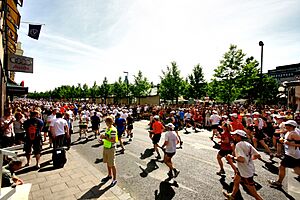
- Stockholm Jazz Festival is one of Sweden's oldest festivals. It takes place at Skeppsholmen in July.
- Stockholm Early Music Festival is the largest international event for historical music in the Nordic countries. It happens in the first week of June.
- The Stockholm Culture Festival is a free cultural festival in August. It is held by the City of Stockholm. It runs at the same time as We Are Stockholm.
- We Are Stockholm is a free youth festival for ages 13 to 19. It runs with the Stockholm Culture Festival in August.
- Stockholm Pride is the largest LGBT Pride event in the Nordic countries. It takes place in the last week of July. It ends with a parade. In 2007, 50,000 people marched, and about 500,000 watched.
- The Stockholm Marathon happens on a Saturday in early June each year.
- The Nobel Banquet takes place at Stockholm City Hall every year on December 10.
- The Stockholm International Film Festival is an annual film festival. It has been held in Stockholm since 1990.
Stockholm's Green Environment

A Green City with a National Urban Park
Stockholm is one of the cleanest capitals in the world. The EU Commission gave the city the 2010 European Green Capital Award. It was Europe's first "green capital." Cities were judged on climate change, transport, green areas, air quality, noise, waste, water use, and more. Stockholm won for its good environmental system. It cut carbon dioxide emissions by 25% per person in ten years. It also plans to be fossil fuel free by 2050. Stockholm has cared about the environment for a long time. Its current environmental program is the fifth since the mid-1970s. In 2011, Stockholm passed the Green Capital title to Hamburg, Germany.
Stockholm as a Role Model
In 2010, Stockholm started a program to share its green practices. This program lets visitors learn about waste management, city planning, and clean transport.
According to the European Cities Monitor 2010, Stockholm is the best city for being free from pollution. It has 219 nature reserves. Stockholm has about 1,000 green spaces. These make up 30% of the city's area. The Royal National City Park was created in 1995. It is the world's first legally protected "national urban park." The water in Stockholm is so clean that people can swim and fish in the city center. Fish like trout and salmon lay eggs in downtown Stockholm's waters. The government aims for Stockholm to be free of carbon dioxide emissions before 2050.
Air Quality in Stockholm
Stockholm used to have problems with small particles in the air (PM10). This was due to studded winter tires. But by the 2010s, levels were below limits. This happened after bans on studded tires on certain streets. Nitrogen oxides from diesel vehicles were a problem in the 2010s. But by 2021, they were also below limits. This was because electric cars replaced diesel ones. Also, pollution rules for trucks became stricter. As of 2021, the only pollutant above limits is ozone. This is due to global pollution.
Getting Around Stockholm
Public Transportation System
Stockholm has a large public transport system. It includes the Stockholm Metro (Tunnelbanan). This has three color-coded main lines with seven routes. There is also the Stockholm commuter rail (Pendeltåget). It runs on state-owned tracks with six lines. There are four light rail/tramway lines. The Roslagsbanan is a narrow-gauge railway with three lines in the northeast. The local railway Saltsjöbanan has two lines in the southeast. There are also many bus lines. The inner-city Djurgården ferry is also part of the system.
Most public transport in Stockholm County is managed by Storstockholms Lokaltrafik (SL). This company is owned by the Stockholm County Council. Since the 1990s, companies like MTR operate the Metro under contract. Boat traffic in the archipelago is handled by Waxholmsbolaget. This company is also owned by the County Council.
SL has one ticket system for all of Stockholm County. This makes it easy to switch between different types of transport. Tickets are either single-use or travel cards. Both allow unlimited travel with SL for the ticket's valid time. A single ticket costs SEK 32 with a travel card and SEK 45 without. It is valid for 75 minutes. A 30-day card costs SEK 860 as of 2018. Students and people under 20 or over 65 get reduced prices. In 2017, the zone system was removed, and ticket costs increased.
The City Line Project
The City Line project cost about SEK 16.8 billion (2.44 billion US dollars). It is an environmentally friendly project. It includes a 6 km (3.7 mi) long commuter train tunnel under Stockholm. It also has two new stations: Stockholm City and Stockholm Odenplan. There is also a 1.4 km (0.9 mi) long railway bridge at Årsta. The City Line was built to double the city's train track capacity. This helps improve service. It opened in July 2017.
The City Line runs through a submerged concrete tunnel between Riddarholmen and Söder Mälarstrand. As a green project, it cleans wastewater. It also reduces noise with special tracks. It uses synthetic diesel for cleaner air. And it recycles excavated rocks.
Roads and Traffic
Stockholm is where major European roads meet. These are E4, E18, and E20. There is a half-finished motorway ring road around the city center. The northern part, Norra Länken, opened in 2015. The final eastern part, which will be underwater, is still being discussed. A bypass motorway, Förbifart Stockholm, is being built for traffic between Northern and Southern Sweden. Building new roads is hard and expensive because of the many islands and waterways. So, new motorways are often built as tunnels and bridges.
Congestion Charges in Stockholm
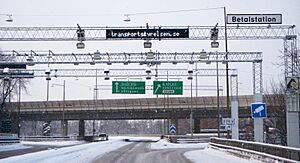
Stockholm has a congestion pricing system. It is called the Stockholm congestion tax. It has been used permanently since August 1, 2007. It had a trial period in 2006. The City Centre is inside the tax zone. All cars entering or leaving this area must pay. There are a few exceptions. The fee is 10–20 SEK (about 1–2 EUR) depending on the time of day. This is between 6:30 AM and 6:29 PM. The most a car can pay per day is SEK 60 (about 6.5 EUR). You pay online or by other means within 14 days. You cannot pay at the control points.
After the trial, people in Stockholm Municipality voted for the tax. Other nearby municipalities voted against it. The government decided to bring back the tax. The money collected now goes to building roads in and around Stockholm. During the trial, the money went to public transport.
Ferries and Water Travel
Stockholm has regular ferry lines to Helsinki and Turku in Finland. These are often called "Finlandsfärjan". There are also ferries to Mariehamn, Åland; Tallinn, Estonia; Riga, Latvia; and Saint Petersburg in Russia. The large Stockholm archipelago is served by boats from Waxholmsbolaget. Many private companies also offer tours and regular service in the archipelago.
City Bikes: A Way to Explore
From April to October, you can rent Stockholm City Bikes. You buy a bike card online or from stores. The cards let you rent bikes from any stand and return them to any other stand. There are two types of cards: a Season Card (April 1 to October 31) and a 3-day card. Bikes can be used for up to three hours per loan. They can be rented from Monday to Sunday, 6 AM to 10 PM. Unfortunately, these bikes have not been a huge success. Some people throw them into the water or damage them. E-scooters also face similar problems.
Airports Serving Stockholm
- International and domestic airports:
- Stockholm Arlanda Airport is Sweden's largest and busiest airport. It had 27 million passengers in 2017. It is about 40 km (25 mi) north of Stockholm. It is a main airport for Scandinavian Airlines.
- Stockholm Bromma Airport is about 8 km (5 mi) west of Stockholm. It is a main airport for BRA.
- Only international airports:
The Arlanda Express airport rail link runs between Arlanda Airport and Stockholm Central Station. The trip takes 20 minutes. It is the fastest way to get to the city center. Arlanda Central Station also has commuter, regional, and intercity trains.
There are also bus lines, Flygbussarna, that run between central Stockholm and all the airports.
As of 2010, there are no airports just for general aviation in the Stockholm area.
Inter-City Train Connections
Stockholm Central Station has train connections to many Swedish cities. You can also take trains to Oslo, Norway; Copenhagen, Denmark; and Hamburg, Germany. The popular X 2000 train to Gothenburg takes three hours. Most trains are run by SJ AB.
Stockholm's Global Recognition
Stockholm often ranks high in international studies. Here are some examples:
- The book The Ultimate Guide to International Marathons (1997) ranked Stockholm Marathon as the best marathon in the world.
- In the 2006 European Innovation Scoreboard, Stockholm was named the most innovative city in Europe.
- In the 2008 World Knowledge Competitiveness Index, Stockholm was ranked the sixth most competitive region globally. It was the most competitive region outside the United States.
- In the 2006 European Regional Growth Index, Stockholm was ranked fifth for expected GDP growth in European cities. It was first in Scandinavia.
- The 2007 European Cities Monitor ranked Stockholm as the best Nordic city for businesses. It also ranked Stockholm first in Europe for being free from pollution.
- A 2007 survey by Matthew Kahn for Reader's Digest magazine ranked Stockholm first as the "greenest" and most "livable" city.
- A 2008 survey by Reader's Digest ranked Stockholm fourth in the world for "honest cities."
- A 2008 survey by National Geographic Traveler magazine ranked Gamla Stan (the Old Town) sixth among historic places.
- A 2008 survey by Foreign Policy magazine ranked Stockholm twenty-fourth among the world's most global cities.
- In 2009, Stockholm was the first city to be awarded the title of European Green Capital 2010.
- In 2013, Stockholm was named the 8th most competitive city in the world by the Economist Intelligence Unit.
- In 2016, Stockholm was one of the cities with the most "unicorn companies" (startups worth over $1 billion) in the world.
- In 2019, Stockholm won the World Smart City Award. This was for its leadership in the GrowSmarter project.
Sister Cities
Stockholm does not have any official sister cities.
See also
 In Spanish: Estocolmo para niños
In Spanish: Estocolmo para niños



